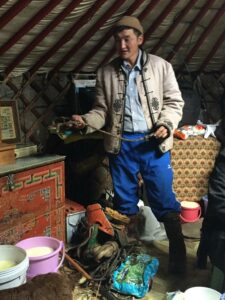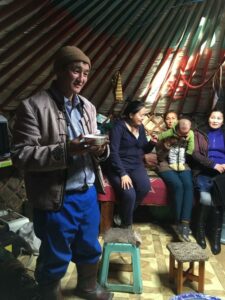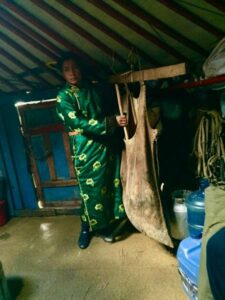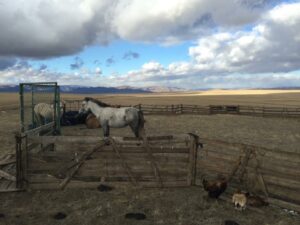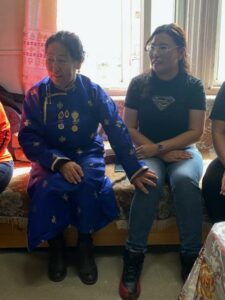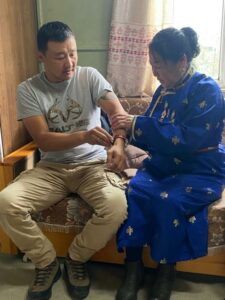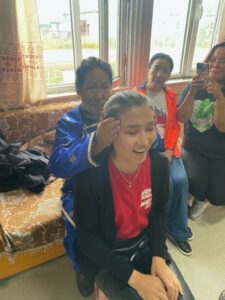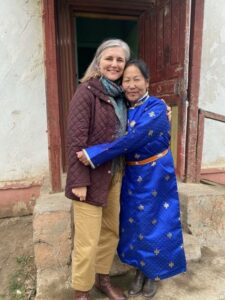Reflections from Three ICH Workshops in Mongolia
Celebrating 20 years of safeguarding living heritage together, reflecting on the road traveled and the way forward.
Since 2015, I have had the honor of serving as a facilitator for the UNESCO global capacity-building programme, which offers training to support states parties in their implementation of the 2003 ICH Convention. Over the past 8 years, I have co-facilitated in-person and online workshops in Bangladesh, the Lao PDR, Myanmar, Mongolia, Malaysia, the Philippines, and Thailand. While I have learned a great deal from working in all these countries, I would like to share some personal reflections about the achievements of the ICH Convention through the lens of my role as a facilitator in Mongolia, where I have co-facilitated capacity-building workshops in 2015, 2017, and most recently in September 2023[1].
Mongolia ratified the UNESCO Convention for the Safeguarding of ICH in 2005, and thus was one of the earliest signatories to the treaty. However, as I learned during my first workshop in Ulaanbaatar in October 2015, even prior to ratifying the Convention, stakeholders in Mongolia’s academic and heritage sector had already been actively engaged in the documentation and revitalization of their living heritage for nearly two decades. The transition from socialism under Soviet influence to a fledgling neoliberal market and democratic system in 1993 ushered in a period of major social, political and economic transformations, including a massive influx of nomadic herders to the city of Ulaanbaatar in search of employment opportunities. Acutely aware of the threats that rapid urbanization, industrialization and globalization posed for traditional nomadic culture, various stakeholders established the National Center for the Intangible Cultural Heritage in 1997, which initiated the work of researching, documenting and promoting Mongolia’s rich nomadic heritage.
While the work of inventorying, researching and documenting Mongolia’s living heritage was already well underway, the 2015 workshop on elaborating nomination files revealed that there was still much to be learned about the core principles and participatory methodologies of the 2003 ICH Convention. As several of the culture officers and workshop participants from Mongolia’s 21 provinces (aimags) explained, they were unfamiliar with the process of free, prior, and informed consent (FPIC), and they were not accustomed to developing safeguarding activities within the framework of a community consultation process. Nevertheless, through the group fieldwork exercise focusing on developing safeguarding plans for four elements of living heritage, workshop participants gained a deeper, hands-on understanding of a community-based, consultative approach.
For example, it was moving to observe the respectful engagement between two groups of participants and a family of herders. On the third day of the workshop, two groups traveled to Töv, approximately 70 kilometers outside of Ulaanbaatar, to meet with a family of herders who raised horses, sheep, and cows to learn more about their living heritage. The groups were welcomed into the ger with fermented mare’s milk called airag and a beautiful Long song (Urtiin Du) sung by the head of household. In consultation and agreement with the male head of the household, one group decided to focus the safeguarding plan on the element of knowledge and craftsmanship related to leather horse harnesses and implements. Speaking with the herder and master horseman, the group learned that more and more herders were abandoning leather straps and harnesses in favor of mass-produced ropes. The result was that not only the knowledge of producing the leather straps was being lost, but also the rituals and practices associated with leather straps were disappearing. One important example given was the miniature whips, harness and stirrups that hang above a baby’s head from birth, in order to tie his spirit to the horse.
Khurelbaatar E. Reciter, Singer of praise, Nalaikh district, Ulaanbaatar city. Photo Credit: Alexandra Denes 2015.
The second group consulted with the female head of household about the threats to her ICH related to herding and horse-rearing and learned that fewer and fewer herders were producing the fermented mare’s milk called “airag” using the traditional methods. Instead of using the large leather sack for fermentation, families were now using plastic containers to store and ferment the milk, which had a negative impact on the flavor and quality of the milk. In terms of its function, “airag” is not only an important source of protein and calcium, but it is also integral for rituals and traditions of the herder.
Traditional technique of making airag in khokhuur and its associated customs, Tsetseg B., Nalaikh district, Ulaanbaatar city. Photo Credits: Alexandra Denes 2015.
As the workshop participants later explained in their final presentations, in-depth consultation with ICH practitioners about the significance, process, and changes to living heritage helped them to understand threats and risks that they would not have been aware of otherwise, and as such, they were better able to develop safeguarding activities that would address these specific threats.
The second workshop that I had the opportunity to co-facilitate in Mongolia took place in September 2017 and was held in Darkhan-Uul province. This was a unique workshop in that it was organized specifically for Mongolia’s media sector. Media from all 21 aimags attended the workshop, with representatives from national television, radio and print media. In the opening session on the first day, the President of the National Confederation of Mongolian Journalists—Mr. Galaarid—explained that Mongolia was in fact bound by law to raise awareness of ICH through the media. Article 49.2.3 of the Mongolian Law on Protection of Cultural Heritage promulgated in 2014 states that the government must “Inform and raise awareness of the public on protection of cultural heritage, traditions, customs, legislations through media.” He went on to describe that Mongolia’s media sector faced numerous challenges, including the weak financial capacity of media outlets and lack of understanding of ICH. Journalists who didn’t specialize in ICH tended to make mistakes, misinforming the public due to lack of understanding about the 2003 Convention and a shortage of in-depth research. In addition, consumers tended to prefer sensational news, and so interest in cultural content was quite low.
One of the issues raised in the discussion had to do with identifying ICH, and the concern among some journalists that they did not know for certain what qualified as ICH. For instance, one participant stated that she would cover the Yak Festival every year, but she had never referred to it as ICH. Another participant noted that some aimags were arguing over who had the “real” or “original” cultural heritage or bearers. My co-facilitator and I clarified that the UNESCO ICH Convention does not have aesthetic criteria or other qualitative criteria for determining what is recognized as ICH. The main criteria are that the ICH must conform to the broad definition of ICH in the Convention (Art.2), as well as mutual respect, universal human rights and sustainable development. Otherwise, there were no criteria based on aesthetic value, originality, or antiquity. Indeed, many discussions over the course of the workshop returned to this idea of “authenticity,” as there was a general perception that the aim of the 2003 Convention was to preserve ICH in its authentic form, when in fact, the Convention does not advocate the freezing of culture.
Starting on the third day, the participants had a chance to engage in community-based fieldwork for their group projects. Each of the five groups were assigned to research and produce a draft of media coverage on an element of living heritage (the skills of traditional embroidery, traditional medicine, traditional milk production, traditional horse healing, and Kazakh folkdance and felt), while adhering to the ethical principles of free, prior, and informed consent as well as respectful consultation with the culture bearers about the media content.
It was fascinating to observe how the participants’ understanding of ICH became more nuanced as they engaged with the living heritage practitioners and reflected on the research process and their findings. For instance, for the group that was assigned to research and document traditional knowledge associated with milk production, the group began by presenting a short video featuring the household they visited to learn about traditional milk products. After the film, the group explained that the family had declined to feature in any news media coverage, as they did not want to be publicized. However, they agreed to the use of their images and footage solely for the purpose of the workshop.
The group then described the stages and components of the milk production process, including the techniques used for milking the mares, and the material components used to prepare and distill the airag (fermented mare’s milk). Several members of the group were themselves knowledgeable about traditional airag fermentation, and pointed out the many ways that the household had modernized or changed the traditional process, such as by using plastic ladles instead of traditional materials, and neglecting to follow certain taboos.
Following the presentation, there was an energetic debate about whether this household was transmitting the knowledge associated with milk production properly or not, with some participants suggesting that they were not, and others suggesting that these changes in the milk production process were an inevitable outcome of socio-economic changes, but they did not represent a diminishment of the cultural meaning of milk production and its role in Mongolian society. All in all, it was clear that the workshop and community-based engagement had prompted participants to think deeply about the meaning of intangible heritage and the media’s role in representing communities and their living heritage.
The most recent workshop that I co-facilitated in Mongolia was held in Ulaanbaatar in September 2023, thus closely coinciding with the 20th anniversary of the UNESCO ICH Convention. In the five years since my last visit, it was clear that Mongolia had gained tremendous momentum in its efforts to safeguard its living heritage. Not only was Mongolia in the process of updating and amending the legal framework for inventorying and safeguarding ICH, but it had initiated a range of programs, including the National Program for Safeguarding Intangible Cultural Heritage (2019-2023), mapping ICH for the Atlas of Cultural Heritage Risks, and the documentation of ICH practitioners through the State Cultural Heritage Registration and Information Fund. The National Center for Cultural Heritage (NCCH) had continued to serve as a key government stakeholder and focal point for ICH programs, including projects and capacity-building workshops with UNESCO Category II Centers (ICHCAP and CRIHAP). The NCCH had also recently moved to its own designated building with offices and facilities to host workshops and ICH events.
The 2023 Training of Trainers focused on safeguarding plans and the linkages between ICH and the sustainable development. A total of 41 participants joined the workshop from various institutions in the heritage sector. Most participants (21) were from the recently established Department of Culture and Arts provincial offices in all 21 aimags. The remaining participants were from libraries, museums, heritage institutes and cultural centers throughout Mongolia. Most of the participants were aware of the 2003 Convention through the listing mechanism, but as in previous years, they were not familiar with many of the core principles, particularly the ethics of free, prior, and informed consent and the community-based, participatory approach. Despite the relative newness of these concepts, the participants embraced them wholeheartedly in their group work, requesting informed consent from practitioners before asking them further questions about the significance of their living heritage and the various threats. Participants also demonstrated openness, concern, and genuine attention and interest when talking with the practitioners, and it was evident that this level of respect strengthened their sense of value of their living heritage.
I observed this dynamic of respectful attention during one working group’s visit with a Biyelgee folk dancer in her home in Bayandchandman soum. After the initial greeting and the kind offer of airag fermented mare’s milk by the host, the group asked for consent to interview and document the dancer. She happily agreed, and the group asked her a series of questions about her own training and her ongoing transmission of Biyelgee to younger generations. She showed the group a ledger full of the names of all her students over the years and several albums of her past performances. The group also documented a brief dance performance and asked her about the meaning of various gestures and movements. Over the course of the lively discussion, they learned that the dancer was also hand healer who could realign the body and set broken bones, and shortly after, everyone in the working group was excitedly taking turns to sit next to the Biyelgee healer for a realignment. One of the workshop participants—a young man—turned out to be incredibly ticklish, and he erupted in uncontrollable giggles when the healer placed her hand on his back. Soon the entire room was laughing. A few moments later, the laughter subsided. The young man was very calm and quiet, and then expressed his surprise that he was no longer ticklish in that spot.
I have shared this vignette of the workshop fieldwork because I feel that it encapsulates so many of the subtle affective aspects of engaging with living culture. On the one hand, the 2003 Intangible Cultural Heritage Convention is an international instrument that necessarily involves a host of obligatory and recommended administrative and managerial tasks, ranging from community-based inventories to nomination files and periodic reports. On the other hand, however, as we saw with the warm exchange between the Biyelgee dancer and the workshop participants, working with living heritage is about demonstrating respect, concern, openness, and care. It is about love, connection, and laughter.
Sarantuya D, Bie bIyelgee dancer and healer, Bayanchandman soum, Tuv province. Photo Credits: Alexandra Denes 2023.
[1] The 2015 workshop was organized by UNESCO Bangkok and the Intangible Cultural Heritage Division, Center for Cultural Heritage of Mongolia (Ministry of Education, Culture and Science of Mongolia), with financial support from the Japanese-Funds-in-Trust. The 2017 workshop was organized by the Council for Cultural Heritage Communication and Networking and the Confederation of Mongolian Journalists. It was hosted by the Center for Cultural Heritage of Mongolia with support from the Ministry of Education, Culture and Science of Mongolia and the Mongolian National Commission for UNESCO, with funding and support from the International Training Center for Intangible Cultural Heritage in the Asia Pacific (CRIHAP). The 2023 workshop was organized by CRIHAP, hosted by the National Center for Cultural Heritage of Mongolia, and with support from the Ministry of Culture of Mongolia, the Mongolian National Commission for UNESCO, and the UNESCO Multisectoral Regional Office for East Asia.
Download PDF: Alexandra Denes – UNESCO ICH Global Facilitator – Thailand – Message.pdf

